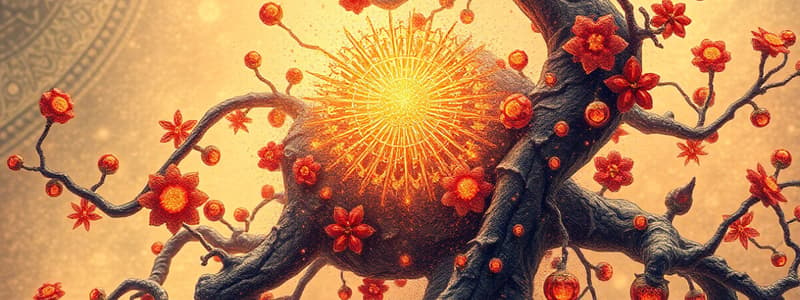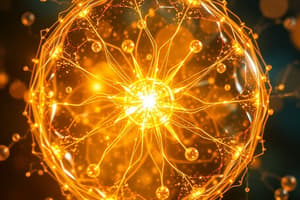Podcast
Questions and Answers
What is the primary function of ATP in energy metabolism?
What is the primary function of ATP in energy metabolism?
- To synthesize glucose
- To provide energy for cellular activities (correct)
- To donate electrons
- To transport oxygen
Which coenzymes are mainly involved in the transduction of energy to ATP?
Which coenzymes are mainly involved in the transduction of energy to ATP?
- NAD+ and FAD (correct)
- Coenzyme A and ATP
- FMN and GTP
- CoQ10 and NADP+
How is ATP synthesized from ADP?
How is ATP synthesized from ADP?
- By oxidation of reduced coenzymes
- Using high-energy phosphate groups (correct)
- Via fermentation processes
- Through the hydrolysis of glucose
What is the net formation of phosphates when lactate is formed from glucose?
What is the net formation of phosphates when lactate is formed from glucose?
What is the greatest quantitative source of phosphates in aerobic organisms?
What is the greatest quantitative source of phosphates in aerobic organisms?
In aerobic organisms, what drives the synthesis of ATP?
In aerobic organisms, what drives the synthesis of ATP?
What type of energy is provided by the hydrolysis of ATP?
What type of energy is provided by the hydrolysis of ATP?
Which activity is NOT fueled by the energy released from ATP hydrolysis?
Which activity is NOT fueled by the energy released from ATP hydrolysis?
What characterizes a spontaneous or exergonic reaction?
What characterizes a spontaneous or exergonic reaction?
What does a positive Gibbs Free Energy indicate about a reaction's spontaneity?
What does a positive Gibbs Free Energy indicate about a reaction's spontaneity?
How are endergonic reactions typically driven in metabolic pathways?
How are endergonic reactions typically driven in metabolic pathways?
In the context of biochemical reactions, what does bioenergetics study?
In the context of biochemical reactions, what does bioenergetics study?
When determining reaction spontaneity at equilibrium, what does Keq > 1 imply?
When determining reaction spontaneity at equilibrium, what does Keq > 1 imply?
What is the standard unit of free energy in biochemical reactions?
What is the standard unit of free energy in biochemical reactions?
Which factor can lead to endergonic reactions occurring in biological systems?
Which factor can lead to endergonic reactions occurring in biological systems?
What is the implication of the statement 'free energy is the useful energy in a system'?
What is the implication of the statement 'free energy is the useful energy in a system'?
What is the significance of common intermediates in energy coupling reactions?
What is the significance of common intermediates in energy coupling reactions?
Under standard biological conditions, what does a negative free energy change indicate?
Under standard biological conditions, what does a negative free energy change indicate?
What is the role of ATP in biochemical reactions?
What is the role of ATP in biochemical reactions?
What is the outcome when the free energy change of a reaction pathway is greater than zero?
What is the outcome when the free energy change of a reaction pathway is greater than zero?
How is free energy represented at standard conditions?
How is free energy represented at standard conditions?
Which statement is true regarding the energy lost during exergonic reactions?
Which statement is true regarding the energy lost during exergonic reactions?
In a coupled reaction, what happens to the free energy of the overall process?
In a coupled reaction, what happens to the free energy of the overall process?
What happens in the electron transport chain regarding proton gradients?
What happens in the electron transport chain regarding proton gradients?
What is the primary function of proton pumps during oxidative phosphorylation?
What is the primary function of proton pumps during oxidative phosphorylation?
Which complex in the electron transport chain directly receives electrons from NADH?
Which complex in the electron transport chain directly receives electrons from NADH?
What type of potential does a strong reducing agent have?
What type of potential does a strong reducing agent have?
What is the role of Coenzyme Q in the electron transport chain?
What is the role of Coenzyme Q in the electron transport chain?
Which statement best describes the process of forming a proton gradient in the electron transport chain?
Which statement best describes the process of forming a proton gradient in the electron transport chain?
What is the primary role of UCP1 in brown adipocytes?
What is the primary role of UCP1 in brown adipocytes?
Which of the following correctly identifies what happens to FADH2 during oxidative phosphorylation?
Which of the following correctly identifies what happens to FADH2 during oxidative phosphorylation?
How does brown adipose tissue (BAT) contribute to energy homeostasis?
How does brown adipose tissue (BAT) contribute to energy homeostasis?
Which component is essential for ATP synthase to function during oxidative phosphorylation?
Which component is essential for ATP synthase to function during oxidative phosphorylation?
In adult humans, what percentage can brown adipose tissue constitute of total body composition?
In adult humans, what percentage can brown adipose tissue constitute of total body composition?
During oxidative phosphorylation, what happens to the electrons after they pass through Complex 1?
During oxidative phosphorylation, what happens to the electrons after they pass through Complex 1?
What distinguishes brown adipose tissue from white adipose tissue?
What distinguishes brown adipose tissue from white adipose tissue?
Which of the following statements is true regarding thermogenic fat?
Which of the following statements is true regarding thermogenic fat?
What is one of the characteristics of adipose tissue in humans?
What is one of the characteristics of adipose tissue in humans?
What mechanism allows brown adipocytes to generate heat?
What mechanism allows brown adipocytes to generate heat?
Which type of adipocyte contributes significantly to non-shivering thermogenesis?
Which type of adipocyte contributes significantly to non-shivering thermogenesis?
Flashcards are hidden until you start studying
Study Notes
Bioenergetics
- Bioenergetics is the study of energy changes associated with biochemical reactions.
- Gibbs free energy (G) is the useful energy available in a system.
- Spontaneous reactions release free energy (ΔG < 0) and are also known as exergonic reactions.
- Non-spontaneous reactions require free energy input (ΔG > 0) and are also known as endergonic reactions.
- The total free energy available from a reaction depends on the change in free energy (ΔG) and the number of moles of reactant converted to product.
- Standard free energies (ΔG°) are measured at 25°C and 1M concentration.
Coupling of Endergonic to Exergonic Reactions
- Endergonic reactions can be driven by coupling them to exergonic reactions.
- The overall net change in Gibbs Free energy for coupled reactions is exergonic.
- Common intermediates facilitate energy coupling.
High-Energy Phosphates
- ATP is the primary energy currency of the cell.
- ATP can donate high-energy phosphate groups to other molecules.
- ADP can accept high-energy phosphate groups to form ATP.
Sources of Phosphate
- Glucose metabolism (glycolysis and Kreb's cycle) generates a net production of two phosphate groups.
- Oxidative phosphorylation in mitochondria is the primary source of phosphate used for ATP synthesis in aerobic organisms.
- Oxidative phosphorylation utilizes the energy from the oxidation of reduced coenzymes (NADH and FADH2).
Electron Transport Chain
- The electron transport chain (ETC) is a series of protein complexes embedded in the mitochondrial membrane.
- The ETC utilizes the reducing power of NADH and FADH2 to generate a proton gradient across the mitochondrial membrane.
- The proton gradient drives ATP synthesis via ATP synthase.
- This process is called oxidative phosphorylation.
- Oxidative phosphorylation depends on the electron transfer potential of NADH and FADH2.
- The reduction potential measures a molecule's tendency to gain electrons.
- Strong reducing agents have negative reduction potentials and readily donate electrons.
- Strong oxidizing agents have positive reduction potentials and readily accept electrons.
- Uncoupling proteins (UCPs) can disrupt the proton gradient, reducing ATP production and generating heat. For example, UCP1 is found in brown adipose tissue and is important for thermogenesis.
- Thermogenic fat tissue is important for non-shivering thermogenesis and energy homeostasis.
- Brown adipose tissue (BAT) contains thermogenic adipocytes and plays a crucial role in whole-body energy homeostasis.
- White adipose tissue (WAT) primarily stores energy.
Studying That Suits You
Use AI to generate personalized quizzes and flashcards to suit your learning preferences.




